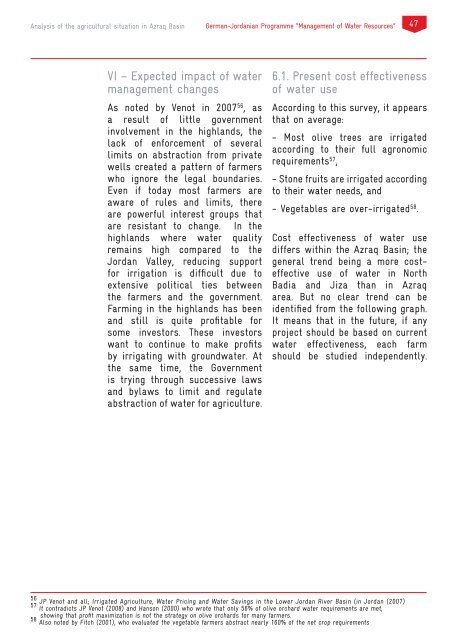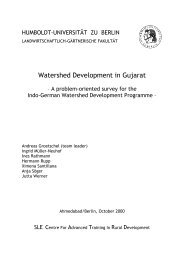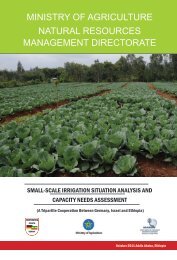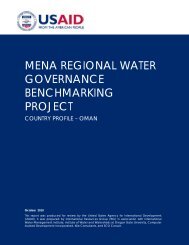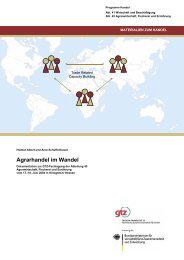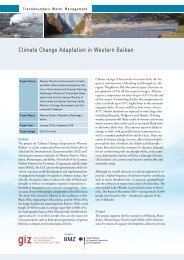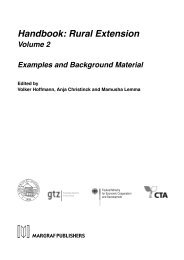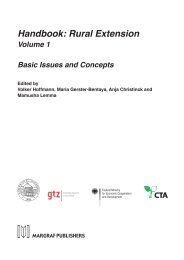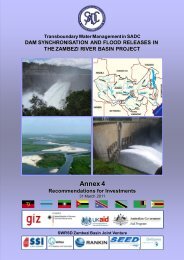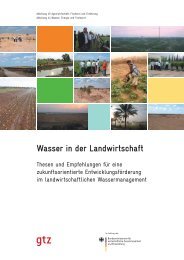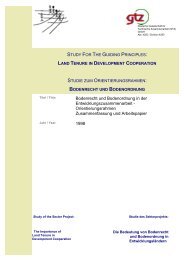Farming in the - WordPress.com
Farming in the - WordPress.com
Farming in the - WordPress.com
Create successful ePaper yourself
Turn your PDF publications into a flip-book with our unique Google optimized e-Paper software.
Analysis of <strong>the</strong> agricultural situation <strong>in</strong> Azraq Bas<strong>in</strong><br />
German-Jordanian Programme “Management of Water Resources”<br />
47<br />
VI – Expected impact of water<br />
management changes<br />
As noted by Venot <strong>in</strong> 2007 56 , as<br />
a result of little government<br />
<strong>in</strong>volvement <strong>in</strong> <strong>the</strong> highlands, <strong>the</strong><br />
lack of enforcement of several<br />
limits on abstraction from private<br />
wells created a pattern of farmers<br />
who ignore <strong>the</strong> legal boundaries.<br />
Even if today most farmers are<br />
aware of rules and limits, <strong>the</strong>re<br />
are powerful <strong>in</strong>terest groups that<br />
are resistant to change. In <strong>the</strong><br />
highlands where water quality<br />
rema<strong>in</strong>s high <strong>com</strong>pared to <strong>the</strong><br />
Jordan Valley, reduc<strong>in</strong>g support<br />
for irrigation is difficult due to<br />
extensive political ties between<br />
<strong>the</strong> farmers and <strong>the</strong> government.<br />
<strong>Farm<strong>in</strong>g</strong> <strong>in</strong> <strong>the</strong> highlands has been<br />
and still is quite profitable for<br />
some <strong>in</strong>vestors. These <strong>in</strong>vestors<br />
want to cont<strong>in</strong>ue to make profits<br />
by irrigat<strong>in</strong>g with groundwater. At<br />
<strong>the</strong> same time, <strong>the</strong> Government<br />
is try<strong>in</strong>g through successive laws<br />
and bylaws to limit and regulate<br />
abstraction of water for agriculture.<br />
6.1. Present cost effectiveness<br />
of water use<br />
Accord<strong>in</strong>g to this survey, it appears<br />
that on average:<br />
- Most olive trees are irrigated<br />
accord<strong>in</strong>g to <strong>the</strong>ir full agronomic<br />
requirements 57 ,<br />
- Stone fruits are irrigated accord<strong>in</strong>g<br />
to <strong>the</strong>ir water needs, and<br />
- Vegetables are over-irrigated 58 .<br />
Cost effectiveness of water use<br />
differs with<strong>in</strong> <strong>the</strong> Azraq Bas<strong>in</strong>; <strong>the</strong><br />
general trend be<strong>in</strong>g a more costeffective<br />
use of water <strong>in</strong> North<br />
Badia and Jiza than <strong>in</strong> Azraq<br />
area. But no clear trend can be<br />
identified from <strong>the</strong> follow<strong>in</strong>g graph.<br />
It means that <strong>in</strong> <strong>the</strong> future, if any<br />
project should be based on current<br />
water effectiveness, each farm<br />
should be studied <strong>in</strong>dependently.<br />
56 JP Venot and all; Irrigated Agriculture, Water Pric<strong>in</strong>g and Water Sav<strong>in</strong>gs <strong>in</strong> <strong>the</strong> Lower Jordan River Bas<strong>in</strong> (<strong>in</strong> Jordan (2007)<br />
57 It contradicts JP Venot (2008) and Hanson (2000) who wrote that only 56% of olive orchard water requirements are met,<br />
show<strong>in</strong>g that profit maximization is not <strong>the</strong> strategy on olive orchards for many farmers.<br />
58 Also noted by Fitch (2001), who evaluated <strong>the</strong> vegetable farmers abstract nearly 160% of <strong>the</strong> net crop requirements


